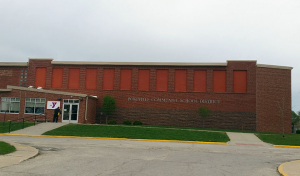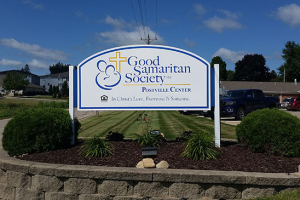The City of Postville, Iowa is just one of four communities selected to participate in the Food Waste Reduction Assistance Project for Iowa Rural Communities. As part of the project, both residents and businesses within Postville have access to many free services and supplies that will help prevent and reduce food waste through a Rural Development grant from the United States Department of Agriculture.
The City of Postville is diverse and has been coined the "Hometown to the World" so it was no surprise the Iowa Waste Reduction Center was eagerly welcomed into the community to help prevent and reduce food waste through various means. One of the most valuable services the Iowa Waste Reduction Center offers is waste audits.
Waste Audit at Postville Community School District
 Postville Community School District's (CSD) Food Service Director, Laurie Smith, invited the IWRC to conduct a cafeteria waste audit. The IWRC met with Smith at Postville CSD on April 18, 2017, to conduct a cafeteria waste audit. The audit began by observing food preparation in the kitchen, food storage, and food disposal methods and was followed by a comprehensive waste sort. Kitchen prep waste was weighed and recorded throughout the day and then students got involved as well. During both breakfast and lunch, students separated waste from their tray into six categories and was then weighed and recorded.
Postville Community School District's (CSD) Food Service Director, Laurie Smith, invited the IWRC to conduct a cafeteria waste audit. The IWRC met with Smith at Postville CSD on April 18, 2017, to conduct a cafeteria waste audit. The audit began by observing food preparation in the kitchen, food storage, and food disposal methods and was followed by a comprehensive waste sort. Kitchen prep waste was weighed and recorded throughout the day and then students got involved as well. During both breakfast and lunch, students separated waste from their tray into six categories and was then weighed and recorded.
- Recyclable items -plastic water bottles, juice cups, plastic clamshells
- Compostable items -napkins and paper boats
- Liquids -milk and juice
- Food waste
- Trash -milk cartons
- Edible uneaten beverages and foods -yogurt, milk, juice, whole fruits
 Postville CSD serves only fresh fruit and vegetables and many of these foods need to be prepared before serving to students. While trimmings from the kitchen are typically thrown away and eventually landfilled, at Postville CSD all fruit and vegetable trimmings are diverted from the landfill through a unique partnership with a local farmer who picks up the trimmings to feed cattle. During this particular waste audit pineapple tops and sides, whole oranges, and asparagus trimmings were laid in boxes at the back door for the farmer to pick up. Later in the day, they were gone and some cows were really enjoying their lunch.
Postville CSD serves only fresh fruit and vegetables and many of these foods need to be prepared before serving to students. While trimmings from the kitchen are typically thrown away and eventually landfilled, at Postville CSD all fruit and vegetable trimmings are diverted from the landfill through a unique partnership with a local farmer who picks up the trimmings to feed cattle. During this particular waste audit pineapple tops and sides, whole oranges, and asparagus trimmings were laid in boxes at the back door for the farmer to pick up. Later in the day, they were gone and some cows were really enjoying their lunch.
A Rural Community Making a Difference
Although Postville CSD generated 119 pounds of food waste from students' trays on the day of the audit, they also diverted more than 140 pounds of food waste from the kitchen to feed livestock. That is a significant amount of kitchen food waste that when extrapolated equals 25,650 pounds (12 tons) of food waste every school year that is picked up by a local farmer to feed cows. And interesting to note, Smith stated that on the day kitchen food waste was measured, they had a lot less than normally diverted.
 Postville can be proud the school district is diverting food waste from the landfill and utilizing these nutrients to feed animals. Additionally, Postville can also be proud of a local nursing home - The Good Samaritan Society. Joshua Carr, Director of Dietary Services at the facility took advantage of the free services offered by the IWRC and scheduled a food waste audit, which occurred on August 11, 2017.
Postville can be proud the school district is diverting food waste from the landfill and utilizing these nutrients to feed animals. Additionally, Postville can also be proud of a local nursing home - The Good Samaritan Society. Joshua Carr, Director of Dietary Services at the facility took advantage of the free services offered by the IWRC and scheduled a food waste audit, which occurred on August 11, 2017.
Waste Audit at the Good Samaritan Society
The Good Samaritan Society in Postville serves many fresh foods to residents of the facility and generates very little food waste. Even Postville locals bring in freshly grown produce from their own gardens to serve. During the morning of the waste audit, many fresh cucumbers were donated to prepare and serve to the residents of the Good Samaritan Society. Later in the day, a creamy fresh cucumber salad made with dill was served and enjoyed. You can't get any fresher than that and it's evident the fresh produce is thoroughly appreciated by staff and residents alike.
Reducing Food Waste
 Another way the Good Samaritan Society reduces how much food they send to the landfill is by repurposing food. Leftover blueberries and other fruits are mixed in with muffins and pancakes the following morning. Leftover baked potatoes are turned into French fries while leftover meats are often put into soups and stews. In an interview with the daily cook, it was noted that a cognizant effort is made to prepare just enough food to feed residents without many leftovers. This was evident at the end of breakfast, lunch, and dinner with very little food waste to measure during the waste audit.
Another way the Good Samaritan Society reduces how much food they send to the landfill is by repurposing food. Leftover blueberries and other fruits are mixed in with muffins and pancakes the following morning. Leftover baked potatoes are turned into French fries while leftover meats are often put into soups and stews. In an interview with the daily cook, it was noted that a cognizant effort is made to prepare just enough food to feed residents without many leftovers. This was evident at the end of breakfast, lunch, and dinner with very little food waste to measure during the waste audit.
Once breakfast, lunch, and dinner were served and eaten, 54 residents of the Good Samaritan Society in Postville threw away 20.4 pounds of food waste on the day of the audit. Daily, this averages to about 0.4 pounds of food waste each resident throws away. In a 2012 report prepared by Business for Social Responsibility for the Grocery Manufacturers Association and the Food Marketing Institute, nursing homes across the country waste an average of 0.6 pounds of food waste per day. This just goes to show the initiatives implemented by the Good Samaritan Society in Postville do make a difference as they waste less food than the national average.
In the kitchen of the Good Samaritan Society, metal and plastic from food packaging are recycled and on the day of the waste audit, there were 1.4 pounds of plastics and 10 pounds of metal cans that were all recycled. Grease is also recycled at the facility. Food waste from the kitchen in the form of prep waste (cucumber peels) and any leftovers that were tossed weighed 17.6 pounds. Yearly, this can be extrapolated to average 6,424 pounds of food waste from the kitchen. Creating community partnerships could be beneficial to divert kitchen prep waste from the landfill, much like the school district has forged. Local farmers may be interested in picking up fruit and vegetable trimmings to feed cattle.
Partnerships to Learn From
Postville is a progressive community when it comes to diverting food waste from the landfill. Both the Postville Community School District and the Good Samaritan Society have implemented strategies to reduce and divert food waste from the landfill. Both of these institutions could benefit from forging a partnership with each other to discuss methods employed to divert food waste from the landfill. Learning from each other's successes and sharing strategies that work will be a win-win for both as well as for the community.
This material is based upon work supported under a grant by the Rural Utilities Service, United States Department of Agriculture. Any opinions, findings, and conclusions or recommendations expressed in this material are solely the responsibility of the authors and do not necessarily represent the official views of the Rural Utilities Service.
The Iowa Waste Reduction Center and the University of Northern Iowa are equal opportunity providers and employers.

